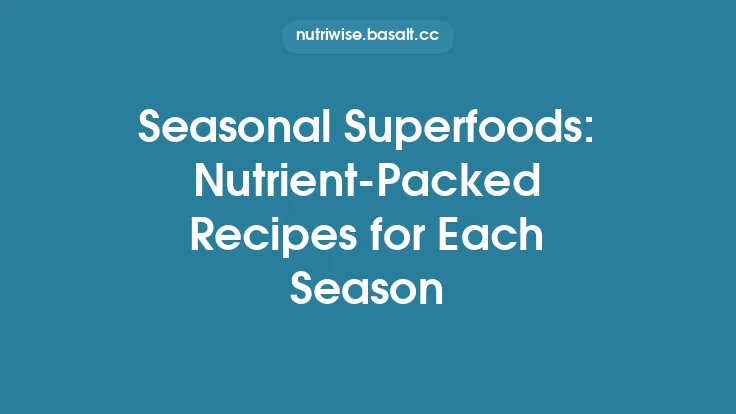Winter’s chill brings more than frosty mornings and shorter days; it also shifts our bodies’ energy demands and cravings toward foods that not only satisfy the palate but also supply the nutrients needed to stay warm, resilient, and thriving. While the concept of “comfort food” often conjures images of indulgent, calorie‑dense dishes, modern nutrition science shows that comfort can be both soothing and nutritionally robust. Below, we explore the principles behind warm, nutrient‑dense winter meals, the ingredients that shine during the coldest months, and practical strategies for turning those ingredients into satisfying, health‑supporting dishes.
Why Winter Calls for Warm, Nutrient-Dense Meals
Thermoregulation and Energy Expenditure
When ambient temperatures drop, the body ramps up thermogenesis—the production of heat—to maintain core temperature. This process consumes additional calories, especially from macronutrients that can be readily oxidized for heat, such as carbohydrates and certain fats. Consuming meals that are both warm and nutrient‑dense helps meet this increased energy demand while also delivering the vitamins and minerals needed for optimal physiological function.
Immune Resilience
Cold weather often coincides with higher incidences of respiratory infections. While no single food can guarantee immunity, a diet rich in high‑quality protein, essential fatty acids, and a spectrum of micronutrients supports the immune system’s cellular machinery. Warm meals also encourage adequate fluid intake, which is crucial for mucosal barrier integrity.
Psychological Comfort
The act of preparing and consuming a hot, aromatic dish can trigger the release of endorphins and serotonin, contributing to mood stabilization during the darker months. This psychological benefit is an important, though often overlooked, component of overall well‑being.
Key Winter Ingredients and Their Nutritional Profiles
| Ingredient | Primary Nutrients | Seasonal Availability | Culinary Role |
|---|---|---|---|
| Root Vegetables (carrots, parsnips, turnips, rutabaga) | β‑carotene, potassium, folate, complex carbs | Harvested late fall, stored through winter | Natural sweetness, thickening agents |
| Winter Squash (butternut, acorn, kabocha) | Vitamin A (as β‑carotene), vitamin C, dietary fiber, magnesium | Peak in late autumn, excellent storage | Creamy texture, base for soups & purees |
| Brassicas (kale, Brussels sprouts, cabbage, collard greens) | Vitamin K, vitamin C, calcium, glucosinolates | Fresh through winter in temperate climates | Bitterness balance, added crunch |
| Alliums (onion, garlic, leeks, shallots) | Sulfur compounds, flavonoids, manganese | Year‑round, stored well | Flavor foundation, aromatics |
| Legumes (lentils, split peas, chickpeas) | Plant protein, iron, folate, soluble fiber | Dried varieties available year‑round | Protein source, thickening element |
| Whole Grains (farro, barley, rye, steel‑cut oats) | B‑vitamins, magnesium, selenium, complex carbs | Stored for months | Base for hearty bowls, texture |
| Healthy Fats (extra‑virgin olive oil, cold‑pressed avocado oil, nuts, seeds) | Monounsaturated & polyunsaturated fatty acids, vitamin E | Shelf‑stable | Satiety, flavor carrier |
| Bone Broth | Collagen, gelatin, calcium, phosphorus, glycine | Made from seasonal animal parts | Soup base, gut‑supportive |
| Spices (cinnamon, ginger, cloves, cumin, smoked paprika) | Antimicrobial compounds, trace minerals | Stored year‑round | Warmth, depth, metabolic stimulation |
These ingredients are not only abundant during winter but also possess complementary nutrient profiles that, when combined, create balanced meals capable of meeting heightened caloric and micronutrient needs.
Building a Balanced Winter Bowl: Carbohydrate, Protein, and Fat
A well‑constructed winter bowl follows the classic macronutrient triangle:
- Complex Carbohydrates (40‑50 % of calories) – Provide sustained energy for thermogenesis. Opt for whole grains (e.g., barley, farro) or starchy vegetables (e.g., roasted squash) as the base.
- High‑Quality Protein (25‑30 % of calories) – Supports immune cell proliferation and muscle maintenance. Include legumes, poultry, fatty fish, or a combination of plant‑based proteins.
- Healthy Fats (20‑30 % of calories) – Enhance satiety, aid absorption of fat‑soluble vitamins (A, D, E, K), and contribute to the sensation of warmth. Drizzle with olive oil, sprinkle toasted nuts, or incorporate avocado.
Example Composition
- Base: 1 cup cooked farro (≈ 35 g carbs)
- Protein: ½ cup cooked lentils (≈ 9 g protein) + 3 oz roasted chicken thigh (≈ 20 g protein)
- Veggies: 1 cup sautéed kale and roasted carrots (rich in vitamins A & C)
- Fats: 1 tbsp toasted pumpkin seeds + 1 tbsp olive oil dressing
- Finish: A pinch of smoked paprika and a squeeze of lemon for brightness
This structure ensures each bite delivers a harmonious blend of macro‑ and micronutrients while keeping the dish warm and comforting.
Hearty Soups and Stews: Techniques for Maximizing Nutrient Retention
1. Start with a Flavorful Base
Sauté a mirepoix of onions, carrots, and celery in a modest amount of oil. This step not only builds depth but also initiates the Maillard reaction, releasing flavor‑enhancing compounds without excessive fat.
2. Layer Ingredients by Cooking Time
Add hard‑root vegetables (e.g., turnips, parsnips) early, followed by softer items (e.g., kale, cabbage) later. This prevents over‑cooking delicate greens, preserving their vitamin C and folate content.
3. Use Low‑Sodium, Homemade Broths
Bone broth or vegetable stock provides collagen, gelatin, and minerals. Simmering bones for 12‑24 hours extracts maximal nutrients; for a quicker option, use pre‑made low‑sodium broth and supplement with a splash of water.
4. Gentle Simmer vs. Rapid Boil
A gentle simmer (≈ 85‑95 °C) reduces the breakdown of heat‑sensitive nutrients, especially vitamin C and certain B‑vitamins, while still allowing flavors to meld.
5. Finish with Acid and Fresh Herbs
A dash of apple cider vinegar or a squeeze of citrus at the end of cooking can enhance mineral absorption (e.g., iron from legumes) and brighten the palate.
Nutrient Retention Tip
If you plan to store soup for later consumption, cool it rapidly (within 2 hours) and refrigerate. Reheat gently on the stovetop rather than microwaving, which can cause uneven heating and nutrient loss.
One-Pot Braises and Casseroles: Comfort Meets Efficiency
One‑pot dishes are ideal for winter because they combine the convenience of minimal cleanup with the depth of flavor that develops from slow cooking. Here’s a technical breakdown of the braising process:
- Searing Phase: Heat a heavy‑bottomed pot (e.g., Dutch oven) to 180‑200 °C and sear protein (e.g., pork shoulder) until a golden crust forms. This creates a Maillard layer rich in flavor compounds and antioxidants.
- Deglazing: Add a modest amount of acidic liquid (wine, cider, or broth) to dissolve the fond (brown bits) stuck to the pot. The acid also helps release iron from the fond, improving iron bioavailability.
- Stewing Phase: Introduce winter vegetables, whole grains, and a larger volume of liquid. Cover and simmer at 90‑95 °C for 1‑3 hours, depending on the protein cut. The low, steady temperature allows collagen to convert into gelatin, yielding a silky mouthfeel and delivering amino acids like glycine, which support sleep quality—a crucial factor during the darker season.
- Thickening: Finish with a slurry of whole‑grain flour or a handful of mashed root vegetables to naturally thicken the sauce without adding refined starches.
Example Recipe Sketch
- Protein: 2 lb pork shoulder, cubed
- Aromatics: 1 large onion, 2 cloves garlic, 1 tbsp grated ginger
- Veggies: 2 cups cubed butternut squash, 1 cup sliced Brussels sprouts, 1 cup kale strips
- Grain: ½ cup pearl barley (pre‑soaked)
- Liquid: 3 cups low‑sodium chicken broth + ½ cup apple cider
- Seasoning: 1 tsp smoked paprika, ½ tsp ground cumin, salt & pepper to taste
- Finish: 2 tbsp toasted hazelnuts, drizzle of extra‑virgin olive oil
Simmer for 2 hours, adjust seasoning, and serve hot. The dish delivers protein, complex carbs, healthy fats, and a spectrum of vitamins and minerals—all in a single, warming bowl.
Winter Grain and Legume Strategies
Whole Grains
- Barley: High in β‑glucan, a soluble fiber that moderates post‑prandial glucose spikes—useful for maintaining steady energy during long, cold days.
- Farro: Offers a nutty flavor and a higher protein content than many other grains, making it a solid base for protein‑rich stews.
- Rye: Contains unique phenolic compounds that may support cardiovascular health; excellent for hearty breads or crisped croutons.
Legumes
- Lentils: Cook quickly (≈ 20 minutes) and provide iron and folate, both essential for red blood cell production.
- Split Peas: Ideal for thick soups; their high lysine content complements the methionine‑rich profile of grains, achieving a more complete amino acid profile when combined.
- Chickpeas: Versatile for roasting (adds crunch) or blending into creamy sauces; they also supply zinc, a mineral involved in immune function.
Combining Grains and Legumes
The classic “protein complement” principle suggests pairing a grain low in lysine (e.g., wheat) with a legume high in lysine (e.g., beans) to achieve a near‑complete amino acid profile. In winter, a barley‑lentil stew exemplifies this synergy, delivering balanced protein without reliance on animal sources.
Incorporating Healthy Fats for Satiety and Warmth
Fats are often misunderstood as merely caloric dense; in winter, they serve several critical functions:
- Thermal Insulation: Dietary fats increase the thermic effect of food, meaning the body expends more energy digesting them, which contributes to internal heat production.
- Fat‑Soluble Vitamin Absorption: Vitamins A, D, E, and K are abundant in winter produce (e.g., kale for vitamin K, winter squash for vitamin A). Consuming them with a modest amount of fat (≈ 1 tbsp oil or a handful of nuts) dramatically improves bioavailability.
- Satiety: Fats slow gastric emptying, prolonging fullness—a benefit when cold weather can trigger frequent snacking.
Practical Sources
- Nuts & Seeds: Toasted walnuts (omega‑3), pumpkin seeds (magnesium), and toasted hazelnuts (vitamin E) add texture and nutrients.
- Oils: Extra‑virgin olive oil for its monounsaturated fats and polyphenols; avocado oil for a high smoke point suitable for searing.
- Dairy & Fermented Fats: Full‑fat Greek yogurt or kefir can be swirled into soups for creaminess and probiotic benefits.
Spices and Herbs: Boosting Flavor and Metabolic Heat
Winter cuisine thrives on aromatic spices that not only enhance taste but also stimulate metabolism and circulation:
| Spice/Herb | Key Bioactive Compounds | Metabolic Effect |
|---|---|---|
| Cinnamon | Cinnamaldehyde | May improve insulin sensitivity, modestly increasing glucose uptake |
| Ginger | Gingerol, shogaol | Thermogenic, promotes vasodilation, supports digestive comfort |
| Cloves | Eugenol | Antimicrobial, adds depth to braised dishes |
| Cumin | Cuminaldehyde | Enhances iron absorption from plant foods |
| Turmeric | Curcumin (often paired with black pepper for bioavailability) | Anti‑inflammatory, supports joint comfort during cold weather |
| Bay Leaf | Eucalyptol | Subtle flavor, aids in digestion of fatty meals |
Application Tips
- Toast whole spices briefly in a dry pan before grinding to unlock volatile oils.
- Add heat‑sensitive spices (e.g., fresh herbs, ground pepper) at the end of cooking to preserve their aromatic qualities.
- Combine spices into a “winter blend” (e.g., 1 tsp cinnamon, ½ tsp ginger, ¼ tsp cloves, pinch of nutmeg) for quick seasoning of roasted vegetables or grain pilafs.
Practical Tips for Meal Prep and Storage in Cold Weather
- Batch‑Cook Grains and Legumes
- Cook large quantities of barley, farro, or lentils, portion into airtight containers, and refrigerate for up to 5 days. Freeze in 1‑cup portions for longer storage.
- Utilize Freezer‑Safe Containers
- Soups, stews, and braised dishes freeze well. Cool to room temperature, then transfer to freezer‑grade bags, removing excess air to prevent freezer burn.
- Rotate Produce
- Store root vegetables in a cool, dark pantry (≈ 4‑7 °C) to extend freshness. Keep leafy greens in a perforated bag with a damp paper towel to maintain crispness.
- Pre‑Portion Healthy Fats
- Portion nuts and seeds into snack‑size bags; toast them just before use to preserve crunch and flavor.
- Mindful Reheating
- Reheat soups and stews on the stovetop over medium heat, stirring frequently to avoid hot spots that can degrade heat‑sensitive nutrients.
- Seasonal Ingredient Checklist
- Keep a running list of in‑season items (e.g., kale, turnips, chestnuts) and plan weekly menus around them to ensure variety and optimal nutrient intake.
Sample Weekly Menu for Winter Comfort
| Day | Breakfast | Lunch | Dinner | Snack |
|---|---|---|---|---|
| Mon | Steel‑cut oats with toasted pumpkin seeds, cinnamon, and a drizzle of maple syrup | Barley‑lentil soup with kale and carrots; side of whole‑grain rye crisp | Braised pork shoulder with butternut squash, Brussels sprouts, and pearl barley | Warm apple slices with a sprinkle of ginger |
| Tue | Greek yogurt parfait with sliced kiwi, toasted walnuts, and a dash of honey | Warm quinoa‑cabbage salad tossed in olive oil, lemon, and toasted cumin seeds | Chickpea‑spinach stew with smoked paprika, served over farro | Roasted chestnuts |
| Wed | Savory oatmeal topped with sautéed leeks, a poached egg, and a splash of hot sauce | Roasted vegetable and lentil bowl (parsnip, turnip, kale) with tahini‑lemon dressing | Salmon fillet glazed with orange‑ginger sauce, side of roasted carrots and rye crisp | Spiced hot chocolate (cocoa, cinnamon, a pinch of cayenne) |
| Thu | Whole‑grain toast with avocado, smoked salmon, and dill | Miso‑infused vegetable broth with tofu, bok choy, and barley | Slow‑cooked beef stew with turnips, carrots, and rosemary, served with mashed cauliflower | Handful of mixed nuts |
| Fri | Buckwheat pancakes with blueberry compote and a dollop of kefir | Warm lentil‑cabbage slaw with apple cider vinaigrette | Vegetarian shepherd’s pie: lentil‑mushroom filling topped with sweet potato mash, seasoned with thyme | Warm pear halves with a drizzle of honey |
| Sat | Scrambled eggs with sautéed kale, onions, and feta | Roasted beet and quinoa salad with orange segments, toasted pumpkin seeds | Chicken thigh braise with rosemary, garlic, and farro, finished with a splash of white wine | Herbal tea with a slice of ginger‑lemon cake |
| Sun | Warm millet porridge with dried apricots, cardamom, and almond butter | Tomato‑bashed bean soup with a side of whole‑grain garlic croutons | Vegetarian chili with black beans, sweet potatoes, and smoked paprika, served over brown rice | Dark chocolate square with a handful of toasted hazelnuts |
This menu showcases a balance of macronutrients, incorporates a wide range of winter produce, and leverages cooking methods that preserve or even enhance nutrient availability. Adjust portion sizes based on individual energy needs, and feel free to swap proteins or grains while maintaining the core principles of warmth, nutrient density, and seasonal relevance.
In Summary
Winter comfort foods need not be synonymous with empty calories. By selecting seasonally abundant ingredients, pairing them thoughtfully to achieve a complete nutrient profile, and employing cooking techniques that preserve heat‑sensitive vitamins while delivering satisfying warmth, you can craft meals that nourish the body, support immune resilience, and lift the spirit during the coldest months. Embrace the season’s bounty, experiment with aromatic spices, and let the simmering pot become a source of both culinary delight and lasting health.





